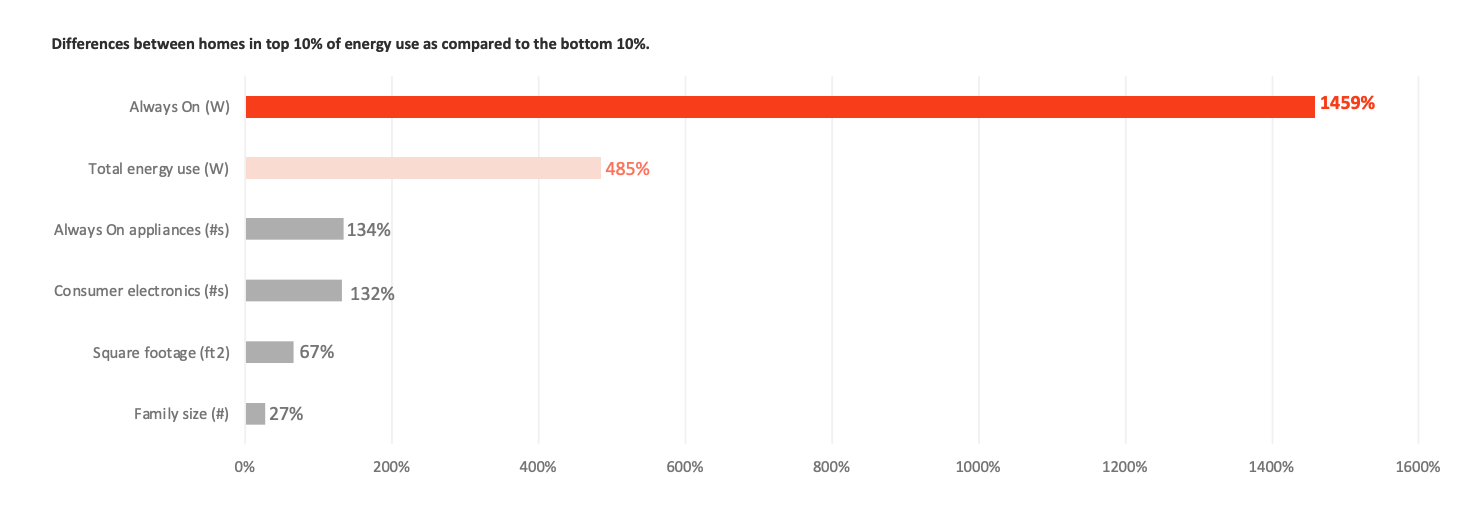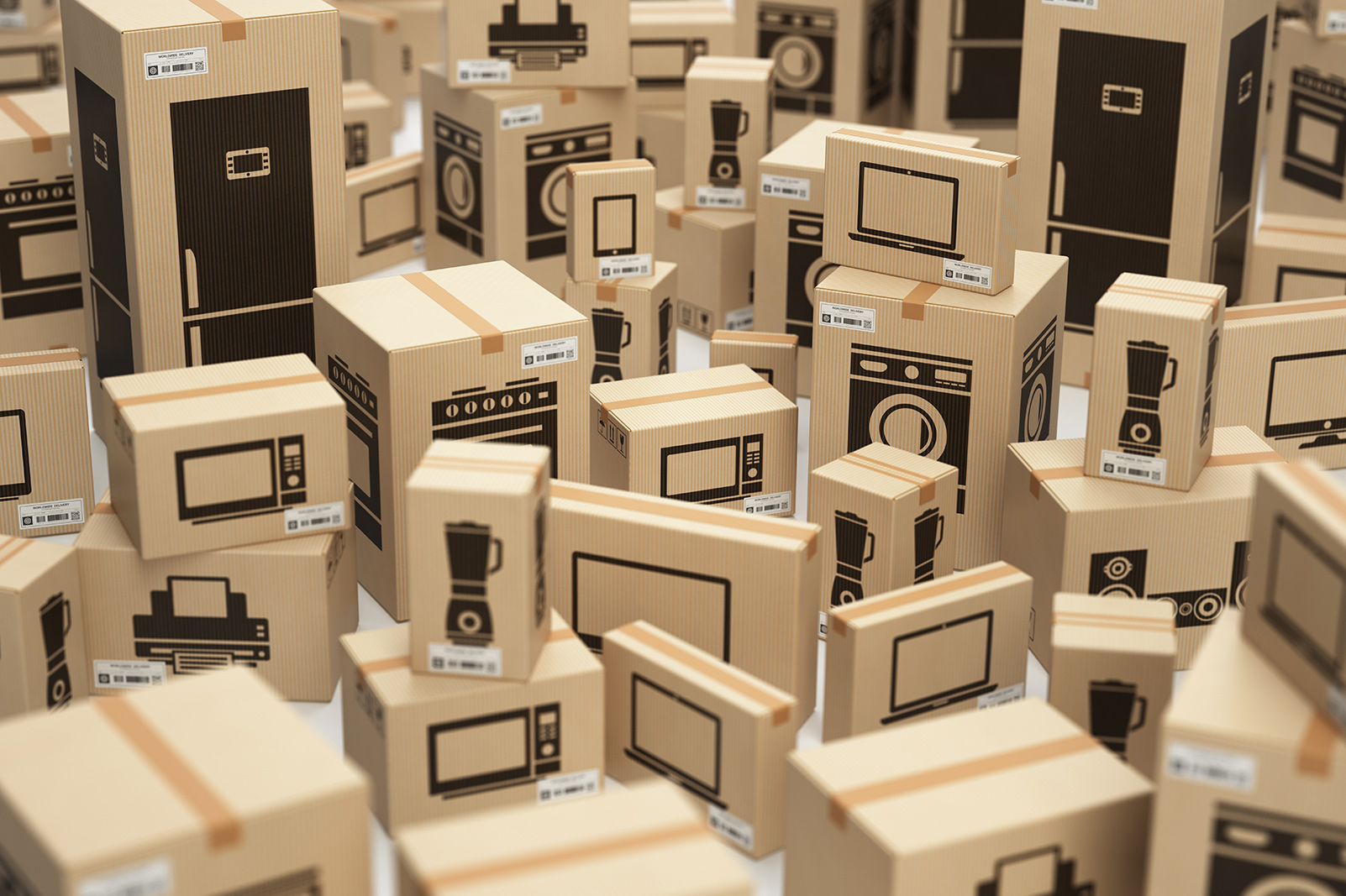How much impact do consumer electronics and other “Always On” devices have on home energy usage? In a 2015 study, the Natural Resources Defense Council estimated that devices that run continuously account for 23% of residential electricity usage. This Always On power use comes from a combination of devices which are running in the background like an internet router, a pool pump,, and devices which appear to be off but continue to consume power like TVs, speakers, and many smart home gadgets.
In September, Sense analyzed the homes of more than 4,000 Sense customers across North America, and confirmed the 23% figure for Always On energy usage. Homeowners pay approximately $308 per U.S. household annually to keep Always On devices running.
In fact, Always On appliances and electronics use more electricity in the average home than lighting, refrigeration, and space heating combined and nearly equivalent to the energy drain from air conditioning and electrical water heating together (source: US EIA).
To assess what contributed to such a high level of Always On usage, Sense customers participated in a survey that has yielded uniquely detailed insights. By combining both sets of data, we learned that consumer electronics, which stay on continuously at various energy levels, are significant drivers of higher energy usage in homes, along with some home appliances.
We discovered that the homes that use the most energy overall — the top 10% — are also the homes that reported the highest numbers of consumer electronics and Always On appliances like aquariums and pool pumps. All those devices humming along add up to a much higher electricity bill and carbon footprint. In short, big homes filled with gadgets that keep running unchecked are wasting lots of energy.
This is the second post in a three-part series of blogs highlighting our findings. You can find our complete, detailed research findings here.
Methodology
With our customers’ permission, Sense analyzed energy data from 4,271 homes whose owners responded also to a brief survey, which asked their zip code, number of household members, the year their house was built, and the total square footage. We also asked respondents to enumerate the consumer electronics and other electrical devices in their homes, choosing from a list of devices that stay on continuously, including consumer electronics such as TVs, streaming media devices, game consoles, and cable boxes, and appliances like dehumidifiers, hot tub heaters, and pool pumps.
Insights
We learned that the electricity that lets you turn on consumer electronics instantly with a click and keep pool water clean has gone from a trickle to a flood that uses almost a quarter (23%) of home energy. This number is consistent with an analysis of Pacific Gas & Electric customers in California, reported by the NRDC in 2015.
Based on the U.S. average monthly utility bill of $111.67 and an average price of $.1289 per kWh, the typical household now spends $308 annually to keep their gadgets running continuously, even when they are not in use.
To understand what factors have the highest impact on Always On energy, we analyzed increases in Always On energy use relative to a home’s total energy use against four variables: family size, home size, number of consumer electronics, and number of always on appliances.

We saw no consistent correlation between family size and energy usage of Always On devices. As family size increased, Always On hovered around the mean.

When we looked at home size, however, we saw a clear correlation: Always On energy increases with home size, relative to the mean, with a steep slope upwards at 4,500-5,000 square feet. A 5,000 square foot home consumes 51% more total energy on average than a 2,500 square feet house and 97% more Always On energy — regardless of family size. Something is going on in larger homes to boost energy usage.

Next, we looked at consumer electronics and found another very strong correlation. In homes with 15 consumer electronics, the total energy usage doubled and the Always On usage quadrupled. Filling your home, whether it’s big or small, with lots of consumer electronics has a strong effect on home energy usage. Your home theater components — TV, DVR, Blu-Ray player, game console, cable box, and streaming device — use more energy than you might think.

Finally, we looked at the data for appliances like pool pumps and hot tubs that run continuously for long periods of time. In homes with 5 of these devices, Always On swelled to 32%, which is 50% above the mean. Pools, aquariums, electric baseboard heaters, dehumidifiers, hot tubs, fans, and security cameras are among the culprits.

Having seen a big jump in energy usage in the largest homes with the most Always On devices, we decided to make another comparison. We looked at the homes in the top 10% of energy consumption — those that consumed 3,090W on average — and compared them to the bottom 10%, who consumed 528W on average.
One would expect that as house and family size grow, homes will have more appliances and electronics and therefore total home energy use and Always On increase in tandem. Instead, Always On accelerates much more rapidly. Homes in the top 10% of energy use (the “guzzlers”) consume nearly 500% more energy than those in the bottom 10% (the “sippers”), but have an Always On that is nearly 1,500% higher. This gap could be explained by homeowners filling large houses with many devices that constantly drain electricity even though they are not used by family members.

In fact, the guzzlers’ energy consumption was so high, they accounted for 30% of total Always On energy use across all 4,270 homes sampled. This analysis points to the outsize impact of the most wasteful homes in the residential energy picture.
Educating homeowners about this hidden energy drain and developing incentive programs through utilities has the potential to significantly reduce energy usage across the country. In our next blog post, we’ll explore the implications of our findings for consumers, utilities, government policy, and climate change.
